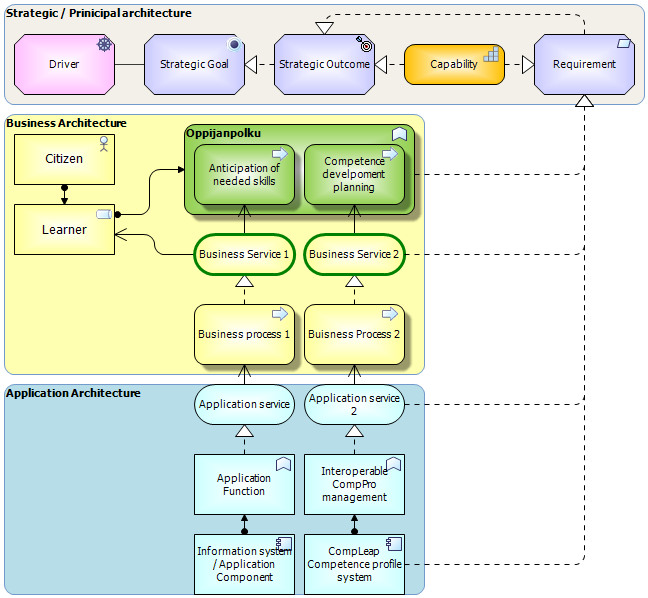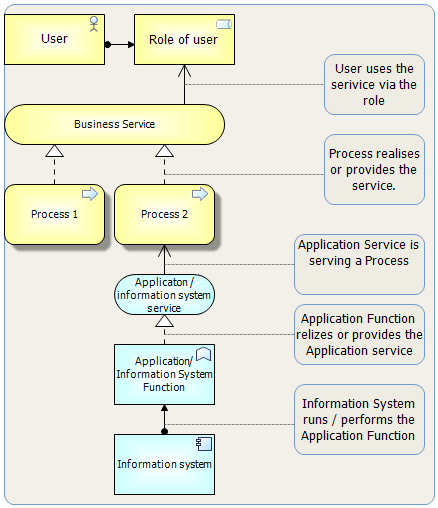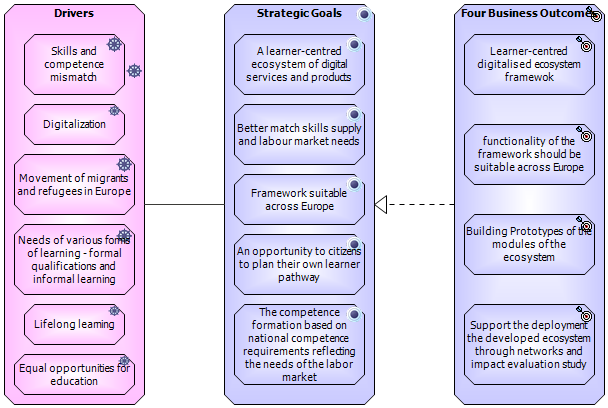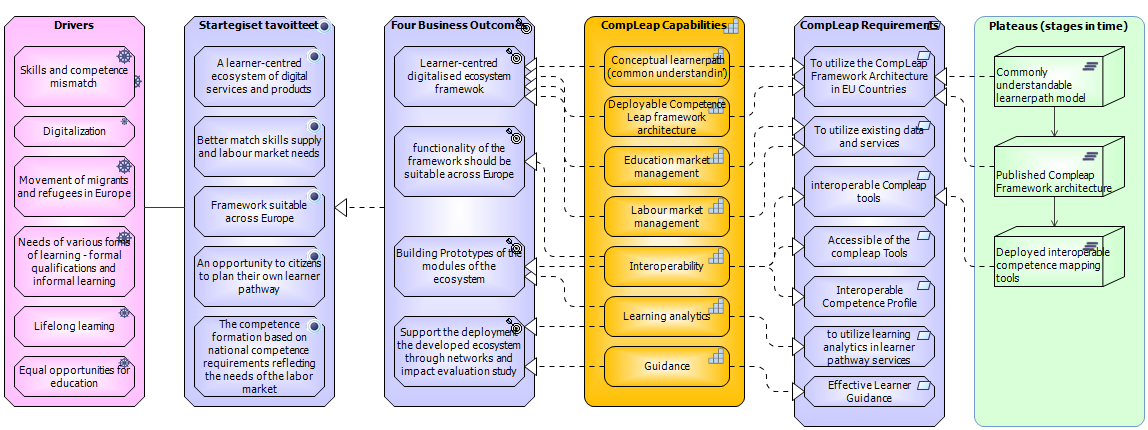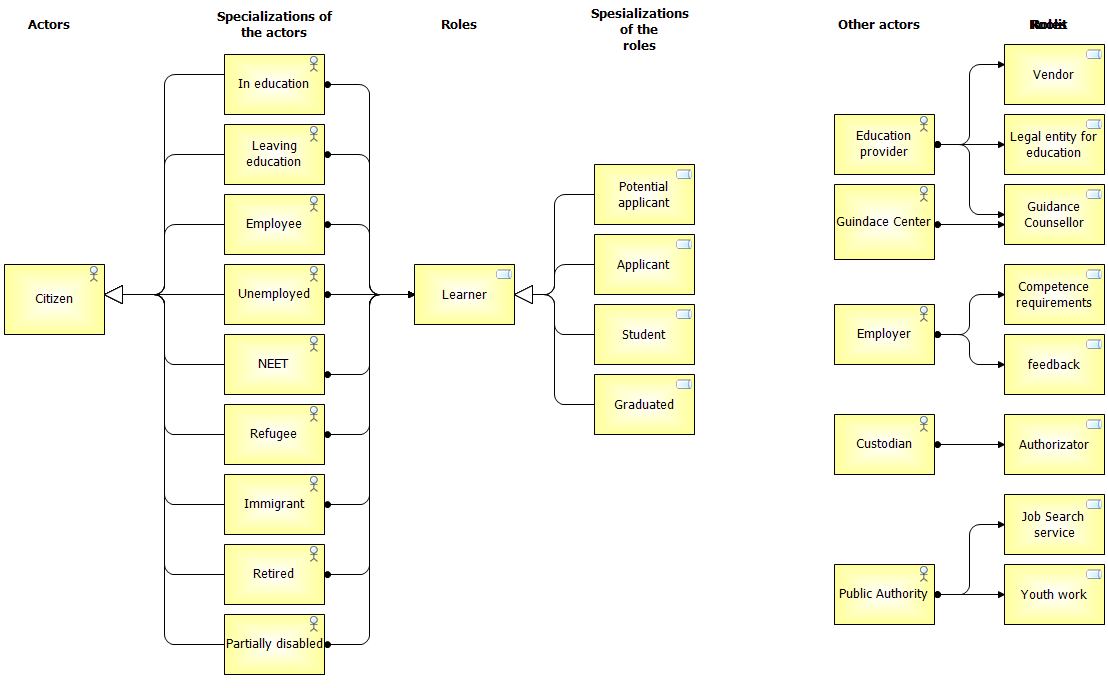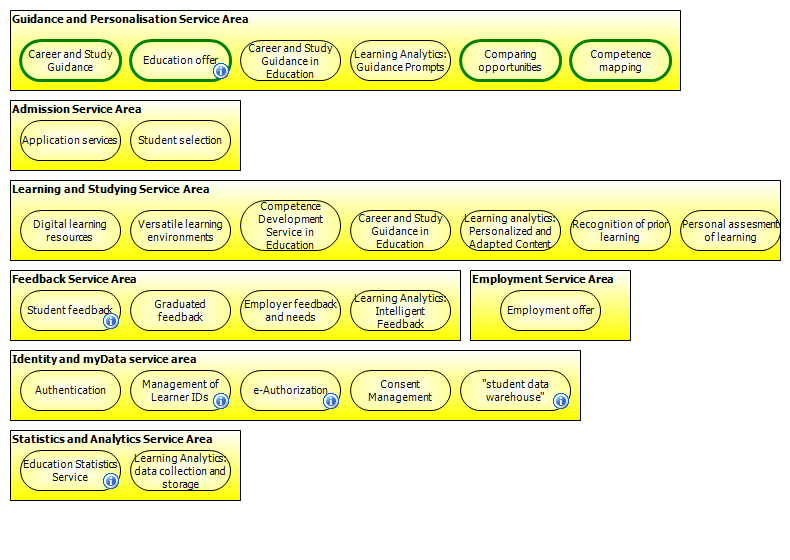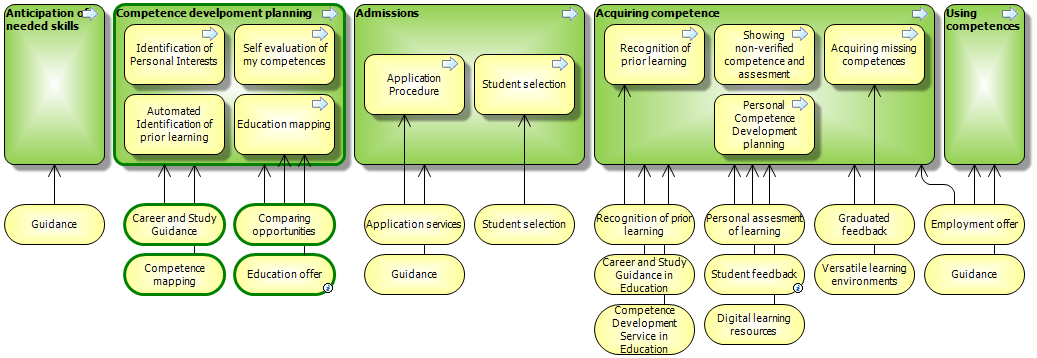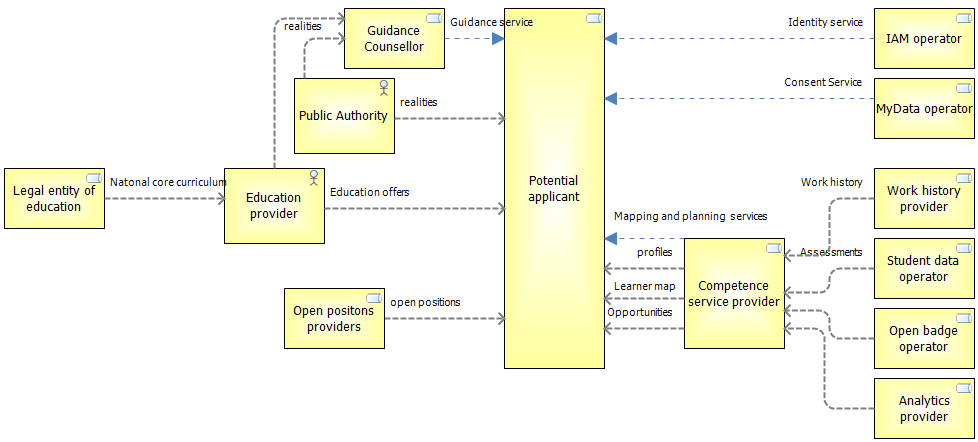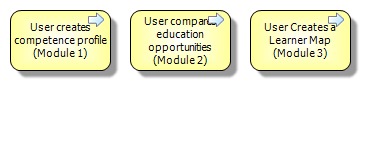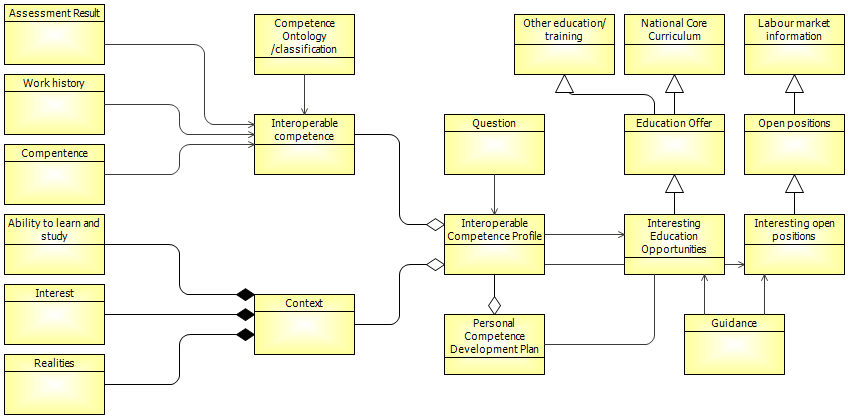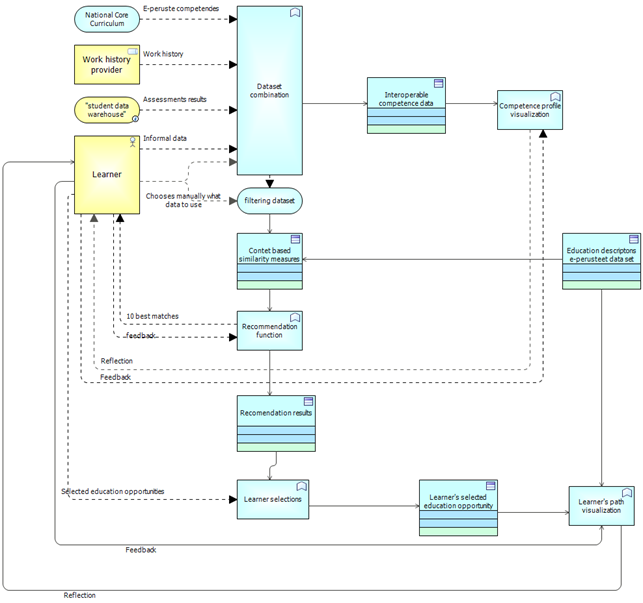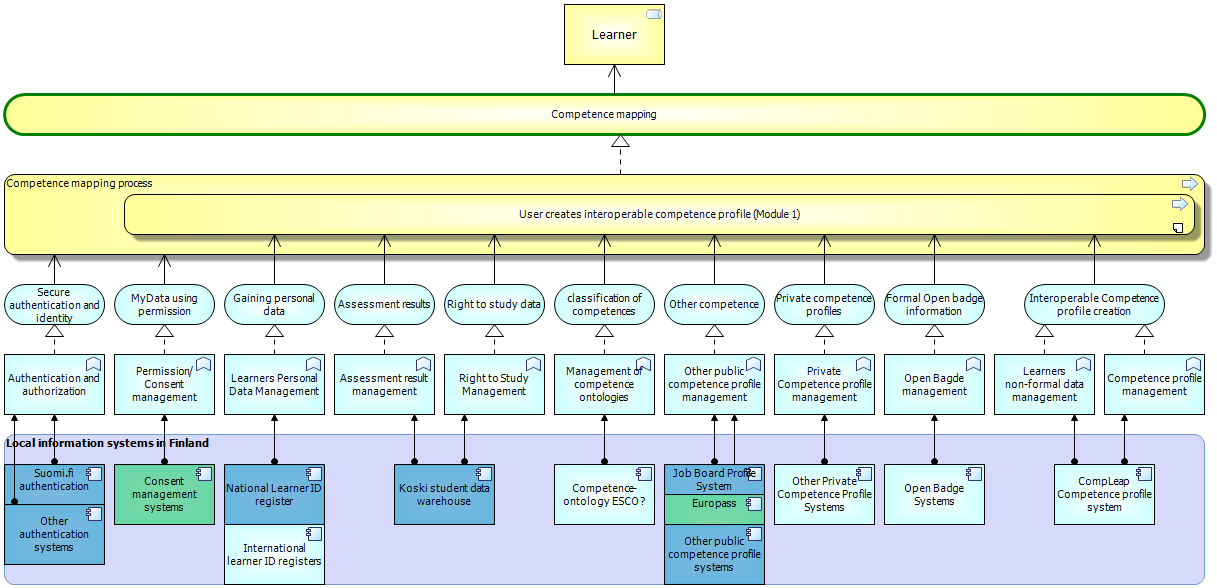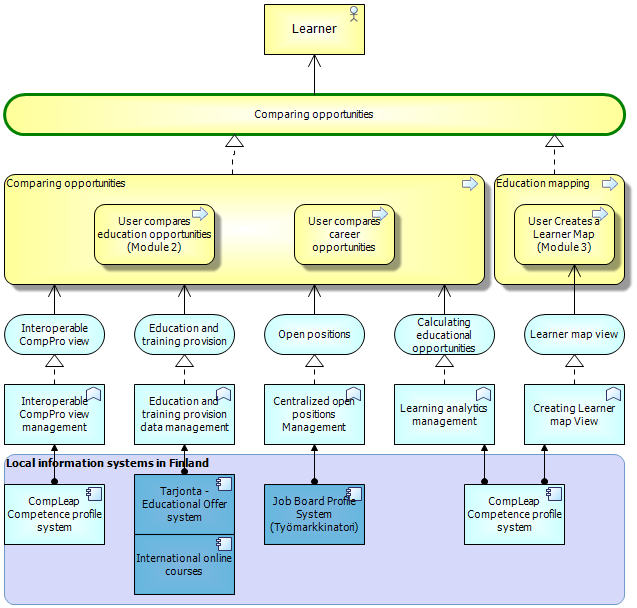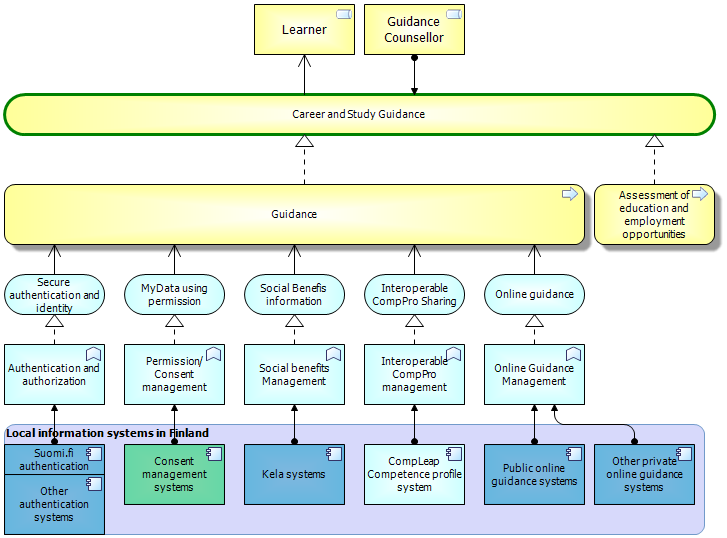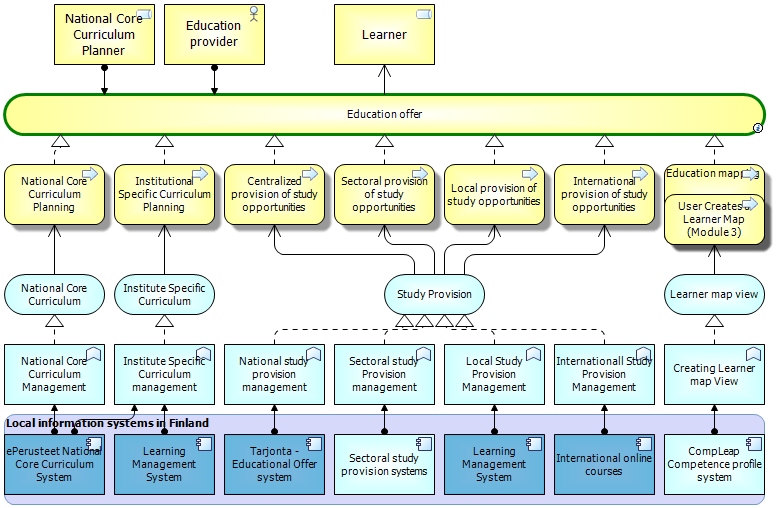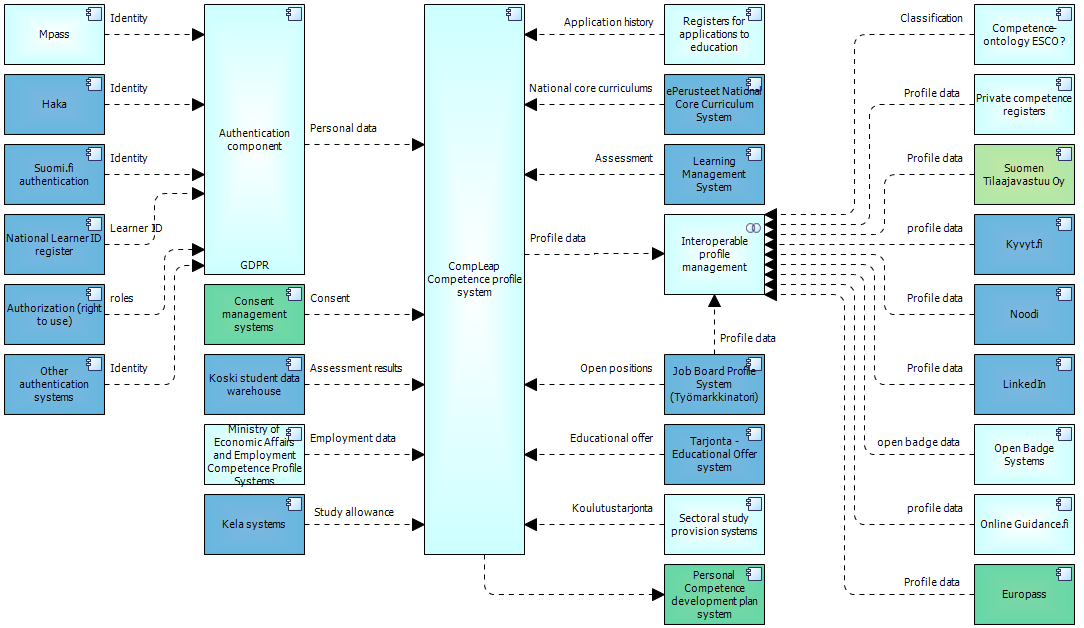Enterprise architecture (EA) is a coherent planning method and a uniform way to describe practices and models for organizations in different stages of the development process. The objective of the EA work is to improve interoperability of activities and services of public administration and private organizations. The main idea of the CompLeap framework architecture can be summarized in this video:
| Widget Connector | ||
|---|---|---|
|
Table of Contents
Below you can find links to the full framework architecture model for the learner-centered service development and learner plan.
Table of Contents type flat
| type | flat |
|---|
Purpose
The framework architecture's purpose is to describe and visualize learner's pathway and available digital services at very generic level so that the framework can be deployed across the EU-member state countries. Such ecosystem framework could be used as a help when developing digital services for citizens.
The learner's pathway can be seen as a value stream which increments learner's competences and, thus, value in some sense. While the value stream is from learner's perspective, the services the learner uses on the path are produced by other actors. The services the learner uses are pinned on the path to tell when the learner is able to use that particular service. By expanding achitecture of the services the framework guides what is needed to implement the services and it is up to a user of the framework architecture to define how the services are actually implemented. To guide
| Table of Contents | ||
|---|---|---|
|
Purpose
The framework architecture's purpose is to describe and visualize learner's pathway and available digital services at very generic level so that the framework can be deployed across the EU-member state countries. Such ecosystem framework could be used as a help when developing digital services for citizens.
The learner's pathway can be seen as a value stream which increments learner's competences and, thus, value in some sense. While the value stream is from learner's perspective, the services the learner uses on the path are produced by other actors. The services the learner uses are pinned on the path to tell when the learner is able to use that particular service. By expanding achitecture of the services the framework guides what is needed to implement the services and it is up to a user of the framework architecture to define how the services are actually implemented. To guide in implementation the framework architecture includes an example how this framework is implemented in Finland.
...
This documentation is meant for
...
The document is meant for decision makersdecision makers, strategy leaders and developers (education and employment services).
Conventions in the document
...
- Compleap Framework Architecture Meta Model
CompLeap vision
...
Architecture principles guide organization development towards strategic goals. Every development decision should be aligned with principles. The power of principles is that everyone can utilized them in their everyday work and work towards strategic goals.
Strategy Map
Strategy map links drivers, strategic goals, business outcomes and capabilities together. Drivers motivate for business shift and strategic goals are long term development targets meeting the environment change. Business outcomes are concrete results realizing the strategic goals in short term development.
...
Strategy Map with Needed Capabilities and Development Requirements
Needed capabilities tell what capabilities organization needs to realize business outcomes. Capability appears when its different dimensions are developed. The different dimensions are people, processes and material. Development of people dimension includes development of personal competences, development of processes include processes, concepts and information management and development of material dimension includes infrastructure, information technology and equipment. CompLeap project development requirements describe what is needed to increase the recognized capabilities.
...
CompLeap Actors and their Roles
The learner's pathway actors and roles are described above. Learner is the center role in the framework architecture and the the learner acts in different specialized roles in the leaner's pathway. The learner can potential applicant, applicant, student or graduated depending on at what stage the learner is in the learner's pathway. Learner can be potentially any citizen of European Union and the citizens are divided into different categories to focus services for them depending on their life situation. From the value stream point of view main actors producing more value to the learner are public authorities, education providers and employers. Education provider offers services to increase learners competencies and employer provides possibility to utilize the competences and turn competences to actual value.
...
Compleap project actors are described above. From the framework point of view the roles are meaningful and the implementer of the framework should consider what roles are required to implement the framework and what are the actors or stakeholders (link to eduuni wp 5) in each role.
Business Service
...
Map
...
Framework's business services are described above. In this framework business service produces value to the learner. The learner starts using the business service by contacting the actor producing the service. The contacting may occur via different channels which are up to an implementer to define. Some of the services require that the learner has to give some information as input to the service and the learner gets information back. Some of the services produce information for the other services to be utilized in the learner's pathway and some services give actual value increment to the learner. The while the business services may be fully automated there is still need for person-to-person interaction and, thus, service design should take other actors in account when applications are defined.
...
Digital Learner Pathway - Target Phase
Learner's pathway is described above. The learner's pathway is main business process or value stream in the framework. The value stream defines the steps the learner takes to increment hers or his competence. The value stream begins from anticipation of needed skills where the learner somehow recognizes the need for new skills or competences. The learner may use guidance at every stage of the leaner's pathway and the guidance could give impulses to the learner at every stage to guide the learner to right direction. After the anticipation of needed skills the learner may do planning or do pre education personal competence development planning. The difference between the planning and pre education competence development planning is that the planning is not well structured process while the pre education personal competence development planning process is. The planning is more ad hoc and flexible and depends on the learner how to planning is done or if it is done at all. The pre education personal competence development planning is defined by legal entity of the education and is formal way to do planning at that stage. After planning the learner does education mapping and after finding proper education, the learner enters to admissions. After admissions the learner acquires competences and finally uses the competences. During acquiring the competences and using the competences the learner does personal competence development planning all the time. The personal competence development planning is also formal process defined by legal entity of the education which guides the learner to do planning all the time. While the learner may do other kind of planning also, the formal planning provides common tools and information to do planning in competence development scope.
...
Digital Learner Pathway - Main and Sub Processes
Learner pathway's sub business processes are described above. The sub processes clarify the main processes and tell in more detail what steps the learner takes in the learner's path.
...
Acquiring competence is divided into recognition of prior learning, showing non-verified competence and assessment, and acquiring missing competences sub processes.
Digital learner pathway: Main Business processes and
...
service
...
Learner's pathway supporting business services are described above. The business services are pinned to the learner's pathway using the arrow notation. The notation describes at which stage of the learner's pathway the business service is utilized. For example learner uses competence mapping business service during planning process.
...
Main and Sub Business Processes and Services
Impact and Socioeconomic effect
...
The socioeconomic effect in this scope can be thought as a sum of all learner's long term impact in a certain time period. This kind of collective impact can be used to help decision making while planning the national core curriculum or budgeting and funding. The prediction of socioeconomic effect could be possible in similar way as in individual's impact prediction and also simulation would be possible in the same way.
Process Integration
Framework process integration is described above. The diagram shows how data concepts flow between processes.
Potential Applicant Interaction
Planning in Learner’s Pathway
...
Learner uses Compleap tool On pre education personal competence development planning process on different stages: competence mapping, comparing opportunities and education mapping. If the learner goes through non-formal planning process the same services can be provided by other tools available in the market. The end result should be still the same, the learner knows what education the learner should acquire and the learner enters into admission process to fill in the education gap.
CompLeap Tool Processes
...
CompLeap tool processes are described above. The processes are part of learner's pathway and in defined in more detail to help implementation of prototypes. The process' details are described in following chapters.
Leaner creates Competence profile (module 1)
The Learner - generic user - starts to use CompLeap tools and creates My competence profile.
...
3. Information Architecture
Conceptual Data Model
The framework's conceptual data model is described above. Main concept is interoperable competence profile (ICP). The interoperable competence profile contains set of interoperable competences and contexts and it is refined by questions. Interoperable competence is built from assessment results, work history, competences and badges. The context is build from interests and realities.
...
The conceptual data model does not tell how the information is actually structured or modeled. From the framework perspective the concepts are recognized as something which is needed to make data flow smoothly among processes.(tehdään keskeisten käsitteiden määrittelyt)
Analytics DataflowData flow
Data flow model in the Compleap project illustrates how data flows in the Compleap user services. Information about formal education, previous work history is gathered automatically from other systems and databases. Information about non formal and informal education as well as interests comes from the manual user (learner) input. Specific data set is extracted and used as a data combination to visualize competences for the user and at the same time stimulate his reflection on his current competence situation. User can also manually select data combination and filters to get a education recommendation. This is content based recommendation. 10 best results are presented to the user where he can further select his favorites and proceed to learners path visualization where information about education option is visualized for the user again to promote his understanding of the studying and also self-reflection. User is also able to give feedback about competence and learners path visualizations as well as education recommendations.
4. Information Systems Architecture (Application Architecture)
Layered Architecture views
Purpose of the models: Show processes, application services and information systems needed for providing CompLeap services.
Competence Mapping layered architecture view
Competence mapping layered architecture view is described above. The diagram describes the competence mapping service is implemented by competence mapping process. When learner uses the service the competence mapping process is executed. The learner gives information about her or himself and process outputs hers or his competences back to the learner.
In CompLeap context the whole competence mapping process is about to be digitalized by module 1 and the process of using digitalized tool is put inside the competence mapping process. In this case, User creates interoperable competence profile process implements the whole competence mapping process but in other implementations there can be manual stages also.
The blue ovals describe the application services supporting the competence mapping process. The application functions are implementations of application services and there could be many application functions which are categorized as same application service. In the diagram only the relevant in the context of the framework are shown.
The lowest row of boxes are systems to which the application functions are assigned in Finland. Thus, the system row is implementation specific.
...
Information flow described above leads to four main services provided: Competence visualization, education recommendation, education comparison and study guidance.
Competence visualization - there are certain competences acquired during the study process. These competences are usually described in the national curriculum and are at the core of the modern world of work and study. Although they are learnt and specified in documentation many students don't have enough information about them or maybe haven't even heard about them at all. Compleap service provides an opportunity to see clearly what competences have been studied during the study process in educational institution. Also what groups they make and what are the main or key competences as described by EU.
Education recommendation - education recommendations are calculated and based on similarity of content between user's profile data and education descriptions.
Education comparison - closest matches of between user's profile and education descriptions are presented to the user in ranking. Starting from the closest one to the less closer and so on. User can mark some recommendations as favorite and this way generate more suitable suggestion.
Study guidance - the whole service is seen as a study guidance and support for decision making. Information about own competences, previous experiences and interests are gathered in one place and presented in a user centered way to promote his reflection about studying possibilities. Education recommendation is provided not as a solution but as an encouragement for the person to think and reflect on his interest and future goals.
User is able to give feedback on the usefulness and accuracy of the the profile and education recommendations to further develop these services.
4. Information Systems Architecture (Application Architecture)
Layered Architecture views
Purpose of the models: Show processes, application services and information systems needed for providing CompLeap services.
This first diagram illustrates overall process of competence development planning and it's subprocesses in CompLeap referece architecture. The rest of the diagrams in this chapter are subdiagrams that drill deeper into smaller architectural components ("Competence mapping", "Career and Study Guidance", "Comparing opportunities" and "Education offer")
Competence Mapping layered architecture view
Competence mapping layered architecture view is described above. The diagram describes the competence mapping service is implemented by competence mapping process. When learner uses the service the competence mapping process is executed. The learner gives information about her or himself and process outputs hers or his competences back to the learner.
In CompLeap context the whole competence mapping process is about to be digitalized by module 1 and the process of using digitalized tool is put inside the competence mapping process. In this case, "User creates interoperable competence profile"-process implements the whole competence mapping process but in other implementations there can be manual stages also.
The blue ovals describe the application services supporting the competence mapping process. The application functions are implementations of application services and there could be many application functions which are categorized as same application service. In the diagram only the relevant in the context of the framework are shown.
The lowest layer are systems to which the application functions are assigned in Finland. Thus, the system layer is implementation specific.
Comparing opportunities layered architecture view
"Comparing opportunities"-service consists of two subprocesses "Comparing opportunities" and "Education mapping". These subprocesses are devided to smaller processes that are supported by application services (blue ovals) which are implemented by application functions. The lowest layer is country/implementation specific and needs to be replaced with local services.
Career and study guidance layered architecture view
*
This diagram illustrates "Career and Study Guidance"-service and again the types of the layers are similar to what can be found in previous diagram. Again lowest layer is country/implementation specific.
Education offer layered architecture view
This diagram illustrates "Education offer"-service.
Application integration: Case Finland
CompLeap Competence profile system Application integration in case of Finland is described above. The system interacts with public authority systems via authentication proxy to meet GDPR requirements. Consent management is new aspect in system development and in Finland learner decides who can access her or his personal data. Interoperable profile management is done in collaboration with other profile related systems.
Analytics Data Flow (case Finland)
Prototype implements only partial solution of above described reference architecture. Analytics data flow diagram below is modified to describe prototype architecture.
User comes to landing page and either logs in or uses system without logging in. If user logs in and has SSN (HETU) then all user related data is brought automatically from various data sources to dataset combination.
Dataset combination can be filtered by the user.
Filtered dataset is used as basis to semantic matching with KTO (KTO is abbreviation for Finnish words Koulutusinformaation, koulutustarjonnan ja Opintopolku.fi -uudistus).
After semantic matching phase user will get personal recommendations based on input data.
After dataset combination competence profile is showed to user (ESCO). (This is right from the "dataset combination".)
In case user do not login (s/he does not have Finnish SSN) then only one data set is automatically fetched for the user ("other competences") and this will be used for recommendations. This is a set of competences that user has selected from a list (national education classification).
Career and study guidance layered architecture view
*
Education offer layered architecture view
Application integration: Case Finland
CompLeap Competence profile system Application integration in case of Finland is described above. The system interacts with public authority systems via authentication proxy to meet GDPR requirements. Consent management is new aspect in system development and in Finland learner decides who can access her or his personal data. Interoperable profile management is done in collaboration with other profile related systems.
